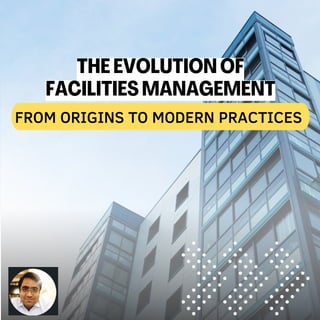The Evolution of Facilities Management From Origins to Modern Practices
"Journey through time and witness the fascinating evolution of Facilities Management. Explore the origins of this vital field, tracing its roots to ancient civilizations, and follow its transformative journey to modern practices. This guide provides insights into how Facilities Management has adapted to meet the changing needs of businesses, technology, and sustainability. Whether you're a facilities manager, a history enthusiast, or simply curious about the evolution of workplace management, join us on this enlightening voyage as we uncover the rich history and innovative trends in Facilities Management." Relevant Hashtags: #FacilitiesManagement #FacilityEvolution #WorkplaceManagement #FacilityHistory #FMOrigins #ModernFacilities #FacilityTrends #FacilityTechnology #Sustainability #WorkplaceInnovation #FacilityAdaptation #FacilityOptimization #WorkplaceEfficiency #HistoricalFacilities #FacilityDevelopment #FacilityMaintenance #FacilityTrends #FMHistory #FacilityDesign #WorkplaceTransformation

Empfohlen
Empfohlen
Weitere ähnliche Inhalte
Mehr von Shamba Sarkar
Mehr von Shamba Sarkar (20)
Kürzlich hochgeladen
Kürzlich hochgeladen (8)
The Evolution of Facilities Management From Origins to Modern Practices
- 1. FROM ORIGINS TO MODERN PRACTICES THE EVOLUTION OF FACILITIES MANAGEMENT
- 2. The history of facilities management (FM) traces back to the late 19th century. Recognizing the need for systematic management of physical assets and workspaces, organizations set the stage for the gradual emergence and evolution of this discipline. Let's delve into key milestones and figures shaping FM's growth.
- 3. In the late 19th century, Frederick Winslow Taylor introduced scientific management principles that optimized work environments. These ideas indirectly impacted efficient spaces and later influenced facilities management concepts. 1. 2. ORIGINS AND EARLY DEVELOPMENTS
- 4. During the early to mid-20th century, organizations began to understand the importance of managing their physical assets. World War II underscored the significance of efficient infrastructure, driving the need for structured facilities management practices 1. 2. EMERGENCE AND GROWTH
- 5. In the 1960s, Dr. Francis Duffy and colleagues in the UK played a pivotal role in formalizing facilities management. Their efforts led to the founding of the British Institute of Facilities Management (BIFM) in 1993, marking a crucial step in the discipline's growth 1. 2. KEY FIGURES AND MILESTONES
- 6. Advancements in computer technology during the 1980s and beyond brought about computerized maintenance management systems (CMMS) andcomputer-aided facility management (CAFM) tools. These innovations improved maintenance tracking and resource allocation 1. 2. INTEGRATION OF TECHNOLOGY & GROWTH
- 7. The 21st century witnessed the rise of smart buildings and the Internet of Things (IoT) applications in FM. These technologies empowered data-driven decisions and proactive management. 1. 2. 21ST CENTURY AND BEYOND
- 8. Environmental concerns prompted the integration of green practices into FM, with a focus on energy efficiency, waste reduction, and sustainable materials SUSTAINABILITY FOCUS
- 9. Recent years have seen FM expanding its scope to enhance workplace experiences. Creating environments that promote collaboration, well-being, and productivity is now a priority. 1. 2. WORKPLACE EXPERIENCE
